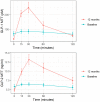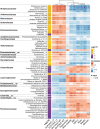A specific gut microbiota signature is associated with an enhanced GLP-1 and GLP-2 secretion and improved metabolic control in patients with type 2 diabetes after metabolic Roux-en-Y gastric bypass
- PMID: 37916149
- PMCID: PMC10616869
- DOI: 10.3389/fendo.2023.1181744
A specific gut microbiota signature is associated with an enhanced GLP-1 and GLP-2 secretion and improved metabolic control in patients with type 2 diabetes after metabolic Roux-en-Y gastric bypass
Abstract
Objective: To determine changes in incretins, systemic inflammation, intestinal permeability and microbiome modifications 12 months after metabolic RYGB (mRYGB) in patients with type 2 diabetes (T2D) and their relationship with metabolic improvement.
Materials and methods: Prospective single-center non-randomized controlled study, including patients with class II-III obesity and T2D undergoing mRYGB. At baseline and one year after surgery we performed body composition measurements, biochemical analysis, a meal tolerance test (MTT) and lipid test (LT) with determination of the area under the curve (AUC) for insulin, C-peptide, GLP-1, GLP-2, and fasting determinations of succinate, zonulin, IL-6 and study of gut microbiota.
Results: Thirteen patients aged 52.6 ± 6.5 years, BMI 39.3 ± 1.4 kg/m2, HbA1c 7.62 ± 1.5% were evaluated. After mRYGB, zonulin decreased and an increase in AUC after MTT was observed for GLP-1 (pre 9371 ± 5973 vs post 15788 ± 8021 pM, P<0.05), GLP-2 (pre 732 ± 182 vs post 1190 ± 447 ng/ml, P<0.001) and C- peptide, as well as after LT. Species belonging to Streptococaceae, Akkermansiacea, Rickenellaceae, Sutterellaceae, Enterobacteriaceae, Oscillospiraceae, Veillonellaceae, Enterobacterales_uc, and Fusobacteriaceae families increased after intervention and correlated positively with AUC of GLP-1 and GLP-2, and negatively with glucose, HbA1c, triglycerides and adiposity markers. Clostridium perfringens and Roseburia sp. 40_7 behaved similarly. In contrast, some species belonging to Lachnospiraceae, Erysipelotricaceae, and Rumnicocaceae families decreased and showed opposite correlations. Higher initial C-peptide was the only predictor for T2D remission, which was achieved in 69% of patients.
Conclusions: Patients with obesity and T2D submitted to mRYGB show an enhanced incretin response, a reduced gut permeability and a metabolic improvement, associated with a specific microbiota signature.
Keywords: bariatric surgery; incretin; microbiota; severe obesity; type 2 diabetes remission.
Copyright © 2023 Hernández-Montoliu, Rodríguez-Peña, Puig, Astiarraga, Guerrero-Pérez, Virgili, López-Urdiales, Osorio, Monseny, Lazzara, Sobrino, Pérez-Maraver, Pérez-Prieto, Pellitero, Fernández-Veledo, Vendrell and Vilarrasa.
Conflict of interest statement
The authors declare that the research was conducted in the absence of any commercial or financial relationships that could be construed as a potential conflict of interest.
Figures



References
-
- Jørgensen NB, Dirksen C, Bojsen-Møller KN, Jacobsen SH, Worm D, Hansen DL, et al. Exaggerated glucagon-like peptide 1 response is important for improved β-cell function and glucose tolerance after roux-en-Y gastric bypass in patients with type 2 diabetes. Diabetes (2013) 62(9):3044–52. doi: 10.2337/db13-0022 - DOI - PMC - PubMed
-
- Wewer Albrechtsen NJ, Hornburg D, Albrechtsen R, Svendsen B, Toräng S, Jepsen SL, et al. Oxyntomodulin identified as a marker of type 2 diabetes and gastric bypass surgery by mass-spectrometry based profiling of human plasma. EBioMedicine [Internet]. (2016) 7:112–20. doi: 10.1016/j.ebiom.2016.03.034 - DOI - PMC - PubMed
Publication types
MeSH terms
Substances
LinkOut - more resources
Full Text Sources
Medical
Research Materials
Miscellaneous

